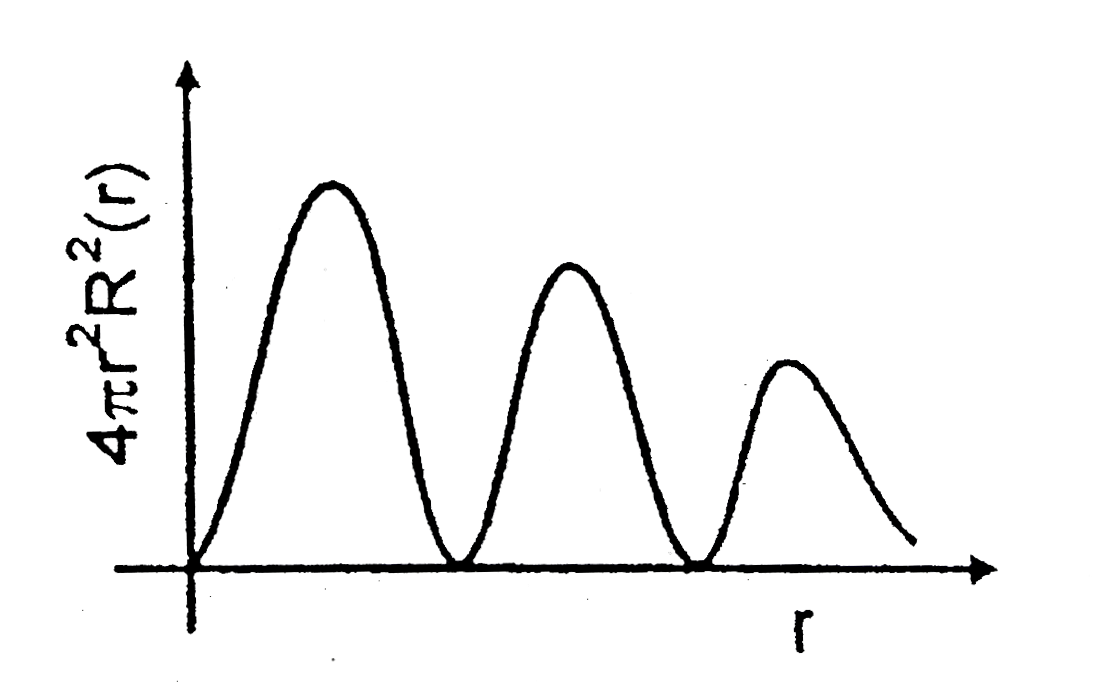For H-atom wave function for a particulaonstate is: Ψ=181√3π(1a0)3/2(σ2−10σ+25)e
Where σ=r/a0 and a0 is Bohr's radius (0.53∘A). Then distance of farthest radius mode is approximately.
0.53∘A
2.12∘A
3.18∘A
1.59∘A
ψ®=0 at tadial nodes
σ2−10σ+24=0
(σ−4)(σ−6)=0
σ=4 and σ=6
farthest radial node at σ=6
ra0=6⇒r=6a0
r=6×0.53∘A
r=3.18∘A
Topper's Solved these Questions
- BOOK - BANSALCHAPTER - TEST PAPERSEXERCISE - CHEMISTRY PART (A)14videos
TEST PAPERS
- BOOK - BANSALCHAPTER - TEST PAPERSEXERCISE - CHEMISTRY PART (B)1videos
TEST PAPERS
- BOOK - BANSALCHAPTER - TEST PAPERSEXERCISE - Chemistry PART D4videos
TEST PAPERS
- BOOK - BANSALCHAPTER - SOLUTIONSEXERCISE - Exercise432videos
SOLUTIONS
- BOOK - BANSALCHAPTER - THERMOCHEMISTRYEXERCISE - Exercise 415videos
THERMOCHEMISTRY
Similar Questions
For a 3s - orbital, value of Φ is given by following realation:
Ψ(3s)=19√3(1a0)3/2(6−6σ+σ2)e−σ/2, where σ=2r.Z3a0
What is the maximum radial distance of node from nucleus?View SolutionThe radial wave equation for hydrogen of radial nodes from nucleus are:
Ψ1s=116√4(1a0)3/2[(x−1)(x2−8x+12)]e−x/2
where, x=2r/a0,a0 = radius of first Bohr orbit
The minimum and maximum position of radial nodes from nucleus are:View Solution
Knowledge Check
- Question 1 - Select One
For a 3s-orbital
Φ(3s)=1a√3(1a0)3/2(6−6σ+σ2)∈−σ/2
where σ=2rZ3aσ
What is the maximum radial distance of node from nucleus?A(3+√3)aσZBaσZC32(3+√3)aσZD3aσZ - Question 2 - Select One
The Schrodinger wave equation for hydrogen atom of 4s- orbital is given by :
Ψ(r)=116√4(1a0)3/2[(σ2−1)(σ2−8σ+12)]e−σ/2 where a0=1st Bohr radius and σ=2ra0 . The distance from the nucleus where there will be no radial node will be :Ar=a02Br=3a0Cr=a0Dr=2a0 - Question 3 - Select One or More
Given the H−atom Rn,l=19√3(1ao)3/2(6−6σ+σ2)e−σ/2
where σ=2Zrnao,ao=0.53Å
Select the correct statement for the given orbital ?
 AOrbital is 3sBGraph for the given orbital is :
AOrbital is 3sBGraph for the given orbital is : CDistance between radial nodes is equal to 3√3aoDNone of these
CDistance between radial nodes is equal to 3√3aoDNone of these
The Schrodinger wave equation for hydrogen atom is Ψ2s=14√2π(1a0)3/2(2−ra0)e−r/a0 , where a0 is Bohr's radius . If the radial node in 2s be at r0 , then r0 would be equal to :
View SolutionFor an orbital in B+4 radial function is :
R(r)=19√6(za0)34(4−σ)σe−σ/2
where σ=Zra0 and a0=0.529Å,Z = atomic number, r= radial distance from nucleus.
The radial node of orbital is at distance from nucleous.View SolutionThe radial wave equation for hydrogen of radial nodes from nucleus are:
Ψ1s=116√4(1a0)3/2[(x−1)(x2−8x+12)]e−x/2
where, x=2r/a0,a0 = radius of first Bohr orbit
The minimum and maximum position of radial nodes from nucleus are:View SolutionAccording to qauntum mechanical model of H-like species, and electron can be represented by a wave function (ψ) which contain all dynamic information about the electron. The nature of wave function depends on the type of the orbital to which the electron belongs. For an orbital
ψ=[√281√3π](1a0)3/2(27−18σ+2σ2)eσ3
Where, σ=(Zra0),r = radial distance from nucleous, a0=52.9pm
The number of radial and angular nodes possible for the orbital given above are respectivelyView SolutionAccording to qauntum mechanical model of H-like species, and electron can be represented by a wave function (ψ) which contain all dynamic information about the electron. The nature of wave function depends on the type of the orbital to which the electron belongs. For an orbital
ψ=[√281√3π](1a0)3/2(27−18σ+2σ2)eσ3
Where, σ=(Zra0),r = radial distance from nucleous, a0=52.9±
The orbital could possibly beView Solution

